
"Habit is stronger than reason."
-- George Santayana, 1900
American philosopher, writer
Suffocation under silage or grain was the leading cause of grain-handling fatalities for the period 1985 through 1989. Many other hazards are also associated with silage and grain storage, such as being crushed by a collapse of crusted material, falling from a bin or silo, or being injured in a fire or explosion.
This section is the third part of a five-part handbook on grain- and silage-handling hazards. Each of the five sections of this handbook is meant to stand alone, so some hazards will be discussed in more than one section. If you have already read one of the other sections of this handbook, some of the material in this section may be a review for you.
Suffocation
Suffocation in grain bins usually occurs when a person is buried while the bin is being emptied. Flat-bottomed grain bins are usually emptied through the center of the bin floor. Shortly after the grain starts flowing, a funnel-shaped flow pattern develops in which grain from the surface flows to the center, then down to the floor in a column (Figure 3-1). A person entering the bin will be carried to the center and quickly drawn under in this column of grain. The flowing grain behaves similarly to quicksand, making escape very difficult. While you usually only sink several inches to a foot in still grain, you can sink to your knees almost immediately in flowing grain. In 10 seconds or less, you will be thigh-deep and unable to free yourself, since the moving grain cannot develop support. Typical unloading rates will completely bury a worker in less than a minute. In addition, some grains, such as flax and millet, cannot support a person, even when still.

| Figure 3-1. When a flat-botomed bin is emptied, a funnel-shaped flow pattern usually develops. Grain from the surface flows to the center, then down to the floor in a column. A worker in the bin will be carried to the center, quickly drawn under, and suffocated. |
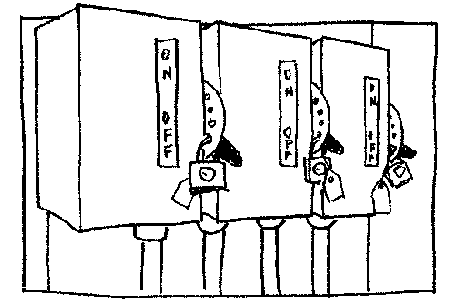
| Figure 3-2. Never enter a forage- or grain-storage structure when it is being loaded or unloaded. The power to all conveying equipment, automatic and manual, should be shut off, locked, and tagged to prevent unexpected operation. |
It has been suggested that permanent safety ropes be placed in grain bins, either hung from the center of the roof or stretched across the grain surface from the roof entrance. Data from human overhead pull- and grip-strength tests and friction tests in grain bins suggest that such ropes are of little value. In fact, these ropes may increase the likelihood of a suffocation by giving people a false sense of confidence that it is safe to enter a bin which is being unloaded. The data indicate that once workers become waist deep, they will not have the strength to hold onto the rope, let alone pull themselves out. The drag forces are so great that many people could not hold on once they were only thigh-deep in the flowing grain. There is also evidence that the drag force against a rope hung from the center of the bin may be able to collapse the roof. The only way to completely avoid burial and suffocation under flowing grain is to shut off and lock out the power to all loading and unloading equipment before workers enter a bin (Figure 3-3).
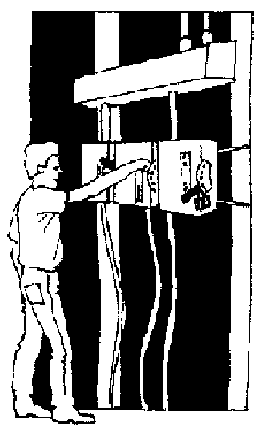
| Figure 3-3. To aviod burial and suffocation under flowing grain, shut off, lock, and tag the power to all loading and unloading equipment before workers enter a bin. |
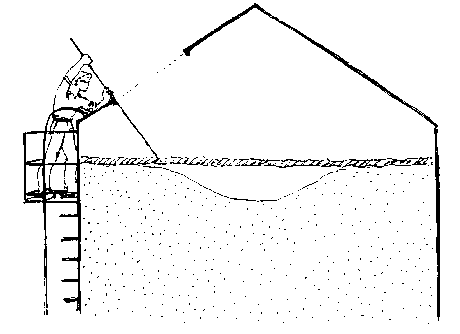
| Figure 3-4. Surface crusts or material sticking to bin walls should be broken up from outside the bin with a wooden pole or weighted line. Never walk onto a surface crust or enter a storage structure below material sticking to the walls. |
A suffocation hazard also exists from the gases given off from spoiling grain. For example, the carbon dioxide (CO2) given off is heavier than air and will collect above the grain surface. You cannot smell, see, or taste the CO2. If enough gas has collected to decrease the oxygen concentration from the normal 21 percent to less than 19.5 percent, you will think less clearly, become drowsy, lose consciousness, or even die. Workers who fall through crusted grain can be killed by CO2 that has collected under the crust, even if they are not completely buried.
If a grain bin must be entered, three people should be used (Figure 3-5). The person entering the structure should wear a safety belt or harness attached to a lifeline. A second person should remain at the bin entrance to watch the person inside the bin and keep tension on the lifeline at all times to prevent the worker in the bin from slipping under the grain. The third person should remain on the ground to go for help or assist in freeing the person in the bin, if necessary. All of the unloading equipment should be turned off, locked, and tagged. If the bin has a ventilating fan, it should be turned on to thoroughly ventilate the bin before entry and should be left on as long as a person is in the bin.
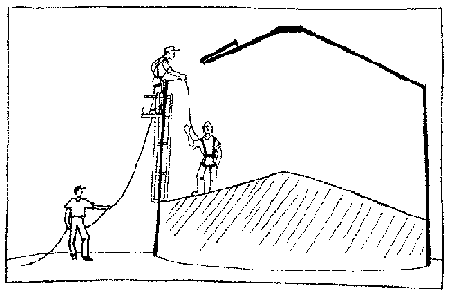
| Figure 3-5. If a grain bin must be entered, three people should be used. The person entering should wear a safety belt or harness and lifeline. A second person should stay at the bin entrance to watch the person inside the bin. The third person should stay on the ground to go for help or assist in freeing the person in the bin, if necessary. |
Silage Structures
Fermenting silage produces nitric oxide (NO), nitrogen dioxide (NO2), and nitrogen tetroxide (N2O4). NO2 and N2O4 are respiratory irritants. Low concentrations of NO2 can cause coughing, difficulty in breathing, or nausea. Higher concentrations may cause the lungs to fill with fluid, which can result in death. These symptoms may be immediate or may be delayed for several hours, for example, until night when the person is asleep.
The highest concentrations of these gases are produced during the first 48 hours after silage is added to the silo, but these gases may be present for the next 4 weeks. The presence of NO2 is sometimes indicated by dead birds or flies under the silo chute. A buildup of gas may be reduced by keeping the silo chute doors open to the silage level, since all three gases are heavier than air. A space between the bottom of the door and the top of the silage, or low spots in the silage surface, can still collect fatal concentrations of gas. Workers could inhale fatal amounts of gas if they fall, or bend over to work or pick up a tool, or even if the gas is stirred up by a draft or the workers' activity. It is best not to enter a silo for 3 to 4 weeks after silage has been added. If entry must be made during this time, the silo should be ventilated with the silage blower or ventilation fans for at least 30 minutes before entry and should be left on as long as someone is inside. Longer ventilation times should be used if the silo is more than 24 feet in diameter or if the silage surface is more than 15 feet from the top of the silo. Even if 4 weeks have passed since silage was added, it is a good practice to thoroughly ventilate the silo before an initial entry is made.
Agriculture Canada has studied the ventilation provided by forage blowers. They recommend attaching wire-wound, flexible, exhaust ducting to the output of the blower pipe so that the end of the ducting is 15 to 30 feet above the silage surface. The flexible ducting prevents the silage distributor from breaking up the air stream and directs the fresh air flow toward the silage surface where the hazardous gases collect. During the Agriculture Canada tests, ventilation was best when all of the chute doors were closed but the roof panel was open. Workers should not climb the chute of a newly filled silo to close the doors or attach ducting, however, since they may inhale NO2 during these activities.
Since silo gases are heavier than air, they may flow down the silo chute and collect in the silo room, if there is one. To reduce the chances of developing a hazardous gas concentration, doors between the silo room and other parts of the building should be closed and the silo rooms windows and doors to the outside should be opened. This safeguard should also be maintained for 4 weeks after silage has been added to the silo.
Bunker Silos
When tractors or other vehicles are used to pack silage into bunker silos, overturns are a definite possibility. The vehicle chosen for this task should have a rollover protective structure and a seat belt. Equipping a tractor with dual wheels may increase its lateral stability and help prevent a sideways overturn (Figure 3-6).

| Figure 3-6. Tractors that are used to pack bunker silos should always have ROPS and seat belts, since overturns are likely. Dual wheels will increase the tractor's lateral stability. |
Falls
Falls from machinery and structures were the second largest single cause of grain- and silage-handling fatalities for the period 1985 through 1989. Falls from structures accounted for 79 percent of these fatalities. The fatality data show that even falls that seem fairly short, 12 to 20 feet for example, can kill a person. Some falls can be prevented by simple safety practices. For example, keep all ladders in good condition and avoid climbing them in wet or icy conditions. Consider using a locking cover or pull-down section for the first 6-8 feet of permanent ladders to prevent access by children or other unauthorized persons (Figure 3-7).

| Figure 3-7. Consider installing guardrails along the roof ladder and around the center roof cover. These guardrails should have top, middle, and toeboards, with the top board 3 1/2 feet high. |
Falls can occur as workers move from the vertical exterior ladders on grain bins to the bin roof or through a bin entrance. Handrails extending 3 1/2 feet above the end of ladders will help workers get onto and off the ladders. Each handrail should be able to support the weight of one worker.
To prevent falls while accessing the center roof openings on grain bins, consider installing guardrails along the roof ladder and around the center roof cover. Ideally, these guardrails should have top, middle, and toeboards, with the top board 3 1/2 feet high (Figure 3-7). Also consider using stair treads instead of a roof ladder and a level work platform instead of roof cleats around the center roof cover, to provide a safer footing. These railings, stair treads, and work platforms can be installed on bins that you already have and on new bins that you may be putting up.
Equipment is also available to prevent serious injuries in case a fall does occur. Most of this equipment uses a waist belt or body harness and a lanyard, which is a short rope or strap, to limit the distance a worker can fall. A body harness is better than a waist belt or a loop of rope around the waist or under the arms, since the harness spreads the force of a fall over a larger part of the body (Figure 3-8). A waist belt or a loop of rope can inflict severe injuries if it is used to stop a fall. Think of how uncomfortable it would be to hang from your waist by a rope loop for even a short time. Falls cause much greater forces than just hanging. If you are selecting a harness, be sure it will fit all of the workers who will be using it. Harnesses with leg, waist, and chest straps and D-ring attachment points in the middle of the back offer the best protection.
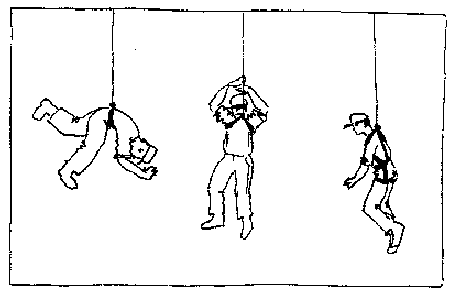
| Figure 3-8. Safety harnesses are preferred to rope or a safety belt, since a belt or a loop of rope around the waist or under the arms can inflict severe injuries if a fall occurs. |
Limited fall protection may be provided by devices that connect the body harness or safety belt to hooks worn or carried by each of the climber's hands. On some of these devices, the hooks will latch around the ladder rungs, rather than just hook over the rung, and are released only by the climber's grip. If the climber only moves one hand at a time, one of the two hooks will be latched to a ladder rung at all times.
When using a fall arresting device, it is important to remember that seemingly short falls can generate very large forces. Components meant to limit a free fall to a distance of 2 to 6 feet should be able to withstand a 5,000-pound load and should be selected very carefully. Fall arrest gear should not allow falls greater than 6 feet. The shorter the fall, the lower the chance of an injury.
If you are repairing or constructing a fall arrest system, try to obtain a rope with end loops woven by the manufacturer. Knots reduce the strength of ropes by about 50 percent. Woven end loops are much stronger. Passing a rope around a sharp corner will reduce the rope's strength by about 70 percent. To prevent these strength losses, snap hooks should be used to attach the safety rope to the worker and the structure. Snap hooks that are meant for animal confinement should not be used unless they have been approved for fall protection use. Also avoid snap hooks that are not self-locking, that is, where the keeper is held only by a spring. Twisting a hook that is not self-locking around a ladder rung or rope, for example, can open the keeper, allowing the hook to come free. Synthetic materials such as polypropylene, polyester, and nylon should be used for safety ropes. Synthetic materials offer some cushioning when they stop a fall, reducing the chance for an injury. Wire rope should be used if hot work, such as welding, is to be done, even though it offers reduced cushioning. Remember that wire rope should not be used near electrical wires.
Safety ropes should be stored carefully. Sunlight, moisture, and many chemicals greatly reduce the rope's strength. Safety specialists recommend that safety ropes be replaced every 7 years, even if they do not appear to be damaged. Some fall protection equipment is not compatible with equipment from other manufacturers. If two brands are mixed, a failure may occur. Consider purchasing fall prevention and protection equipment from a safety gear manufacturer or retailer who has experience with these devices.
Fires, Explosions, and Electrocutions
Fires, explosions, and electrocutions are not as common as falls, but can have equally severe results when they do occur. Fires and explosions in grain storage are generally due to dust or grain-drying equipment. The risk of a dust explosion or fire can be reduced by preventive maintenance. Regularly checking and servicing bearings, belts, and conveyors will help to prevent overheating from lack of lubrication, slippage, or rubbing. Thoroughly ventilating the bins with the dryer fans before igniting the dryer will reduce the risk of a fire or explosion from leaking fuel. If you use liquified petroleum (LP) gas for grain drying, be sure to use pipe, tubing, hose, fittings, and valves specified for LP gas use by the manufacturer. LP storage tanks should not be located right next to each other or right next to buildings or grain dryers, to reduce the risk of a fire or explosion. The National Fire Protection Association recommends distances between LP storage tanks and buildings or between adjacent tanks based on the tank capacity. Check with your gas supplier or county extension agent to be sure that your LP tanks are located according to these recommendations.
Regularly cleaning grain material from the inside and outside of grain dryers will decrease the chances of a fire. The risk of a fire can also be reduced by keeping the air intake screens clean and in good condition so combustible material cannot be pulled in with the air.
Grain dryers may have a variety of automatic controls, including:
Fires are also caused by electricity. Permanently connecting all fans, dryers, and unloading equipment with underground wiring will help to reduce faulty electrical connections. For 120-volt electrical outlets, consider installing ground fault circuit interrupters, commonly called GFCI's. These devices will shut off power to a faulty electrical circuit before that circuit leaks sufficient current to kill a person.
When revising or adding electrical circuits, make sure whoever does the work is familiar with the recommended practices for agricultural wiring. Agricultural wiring environments are more harsh than those in the home. You can create electrocution or fire hazards if the proper practices and equipment are not used.
| Go to Section 2 | Go to CONTENTS | Go to Section 4 |
This page was last updated on December 8, 1995.